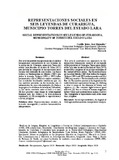| dc.rights.license | http://creativecommons.org/licenses/by-nc-sa/3.0/ve/ | es_VE |
| dc.contributor.author | Castillo Sivira, José Alejandro | |
| dc.date.accessioned | 2020-11-20T14:27:16Z | |
| dc.date.available | 2020-11-20T14:27:16Z | |
| dc.date.issued | 2020-11 | |
| dc.identifier.issn | 0798-1570 | |
| dc.identifier.uri | http://www.saber.ula.ve/handle/123456789/47085 | |
| dc.description.abstract | Este artículo postula una aproximación al análisis
hermenéutico interpretativo de seis leyendas de
la población de Curarigua, municipio Torres del
estado Lara ubicadas en la obra de Silva (1971)
para develar las categorías de las representaciones
sociales del contenido de esos relatos. Las bases
teóricas se fundamentan en Morote (2005) que
defi ne la leyenda, Todorov (1981 y 1992) sobre
hermenéutica y Eco (1986) en cuanto a semiótica.
Los resultados localizados establecen que: (a)
Los motivos presentes en las leyendas son el
inframundo y los seres sobrenaturales, (b) Nada es
lo que parece o el dilema de la belleza y la fealdad,
(c) La lucha constante entre el bien y el mal,
(d) Los pecados como forma de estancamiento
humano ante los valores y la trascendencia
espiritual y (e) El curarigüeño es supersticioso y
a la vez, religioso. | es_VE |
| dc.language.iso | es | es_VE |
| dc.rights | info:eu-repo/semantics/openAccess | es_VE |
| dc.subject | Representaciones sociales, la leyenda curarigüeña y análisis hermenéutico interpretativo. | es_VE |
| dc.title | Representaciones sociales en seis leyendas de Curarigua, municipio Torres del estado Lara | es_VE |
| dc.title.alternative | Social representations in six legends of Curarigua, municipality of Torres del estado Lara | es_VE |
| dc.type | info:eu-repo/semantics/article | es_VE |
| dcterms.dateAccepted | Mayo-2020 | |
| dcterms.dateSubmitted | Mayo-2020 | |
| dcterms.publisher | SaberULA | |
| dc.description.abstract1 | This article postulates an approach to the
interpretive hermeneutic analysis of six legends
of the population of Curarigüa, Torres municipality
of the Lara state located in the work of Silva (1971)
to unveil the categories of social representations of
the content of those stories. The theoretical bases
are based on Morote (2005) that defi nes the legend,
Todorov (1981 and 1992) on hermeneutics and Eco
(1986) on semiotics. The localized results establish
that: (a) The motives present in the legends are the
underworld and supernatural beings, (b) Nothing
is what it seems or the dilemma of beauty and
ugliness, (c) The constant fi ght between good
and evil, (d) Sins as a form of human stagnation
before values and spiritual transcendence and (e)
The curarigüeño is superstitious and, at the same
time, religious. | es_VE |
| dc.description.colacion | 5-21 | es_VE |
| dc.description.email | cifranueva@ula.ve | es_VE |
| dc.description.email | castillosivirajose97@hotmail.com | es_VE |
| dc.description.frecuencia | Semestral | |
| dc.description.paginaweb | http://www.saber.ula.ve/cifranueva/ | |
| dc.identifier.depositolegal | P P92-0047 | |
| dc.identifier.edepositolegal | ppi 201202ME4019 | |
| dc.identifier.eissn | 2244-8438 | |
| dc.publisher.pais | Venezuela | es_VE |
| dc.subject.institucion | Universidad de Los Andes | es_VE |
| dc.subject.keywords | Social representations, the legend of Curarigüa and hermeneutic interpretative analysis | es_VE |
| dc.subject.seccion | Cifra Nueva: Estudios | es_VE |
| dc.subject.tipo | Artículos | es_VE |
| dc.type.media | Texto | es_VE |


